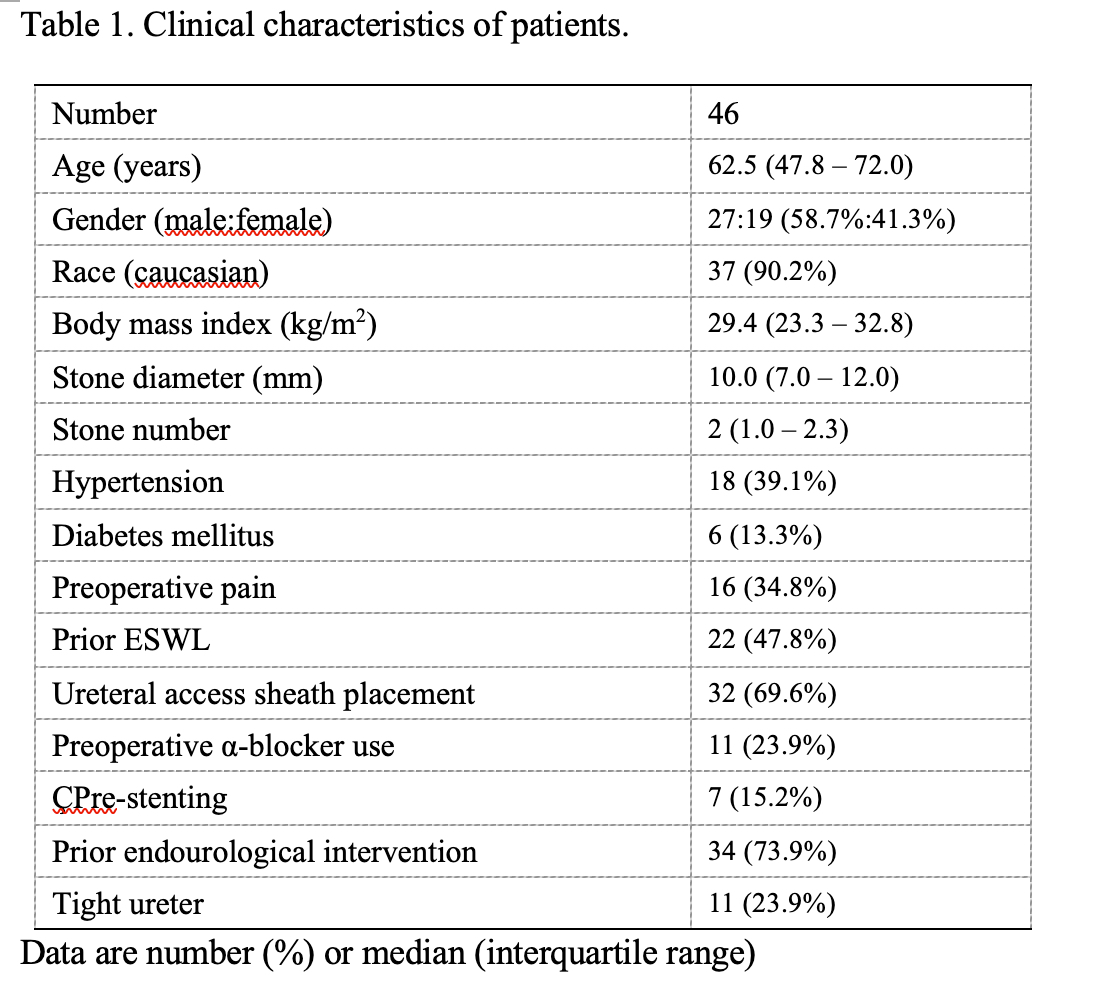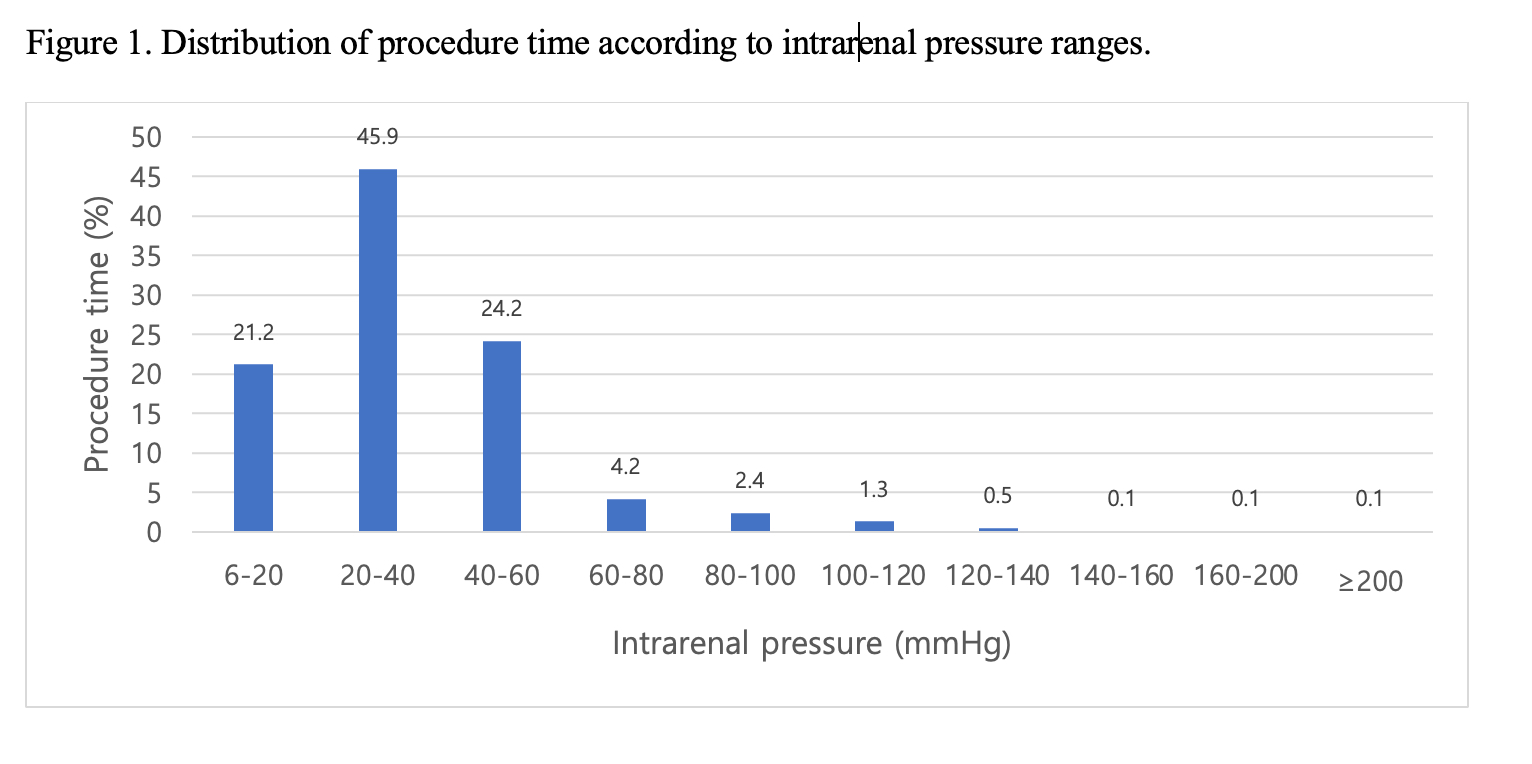Back
Introduction: Intrarenal pressure (IRP) is thought to play a role in complications following ureteroscopy. This area is poorly studied because of the difficulty in routinely measuring IRP. We report on our first-in-human experience using the LithoVue EliteTM ureteroscope (Boston Scientific).
Methods: A single-arm retrospective observational analysis was performed in 46 consecutive patients undergoing ureteroscopic lithotripsy using the LithoVue Elite™ system with pressure sensing capability between April-October, 2022 at 2 centres. A pressure bag set at 150mmHg or hand irrigation with a 60cc syringe was used for irrigation and a ureteral access sheath (UAS) was placed at the physician’s discretion. Median and maximum IRPs, and relative cumulative time exceeding 20, 40, 60, 80, 100, 120, 140, 160, and 200 mmHg per total procedure time were analyzed. The two-sample Mann-Whitney U-test was used with a statistical significance set at p<0.005.
Results: Median patient age and body mass index (BMI) were 62.5 (IQR 47.8–72.0) years and 29.4 (23.3–32.8) kg/m2 (Table 1). During the median total procedure time of 31.9 (IQR 17.4–44.9) minutes, median and maximum IRPs were 30.0 (IQR 21.0–51.5) and 177.0 mmHg (IQR 129.0–266.0), respectively. IRP remained below 60 mmHg 91.3% of the procedure times (Fig 1). Patients with Asian ethnicity and hypertension had higher pressures and a longer relative cumulative time =20 mmHg compared to others, while patients with tight ureters and without UAS use exhibited longer cumulative times =60 mmHg . The smaller 10/12 Fr UAS did not lower pressures as much as the 11/13 Fr and 12/14 Fr UAS (p < 0.001). Age, pre-stenting, preoperative a-blockade, and BMI did not show any statistically significant associations with IRP.
Conclusions: IRP can now be routinely measured during ureteroscopy. Patients had a median IRP of 30 mmHg and a maximum of 177 mmHg. The use of a smaller UAS ( <12/14 Fr), Asian ethnicity, hypertension and tight ureters were found to have higher IRPs in our study. SOURCE OF
Funding: None.


Podium Session
Session: PD28: Stone Disease: Surgical Therapy (including ESWL) III
PD28-07: First-in-human experience using the LithoVue&[trade] Elite Single Use Ureteroscope to measure Intrarenal Pressure: the Canadian Experience
Sunday, April 30, 2023
10:30 AM – 10:40 AM CST
Location: S401C

Ben Chew, MD, MSC, FRCSC (he/him/his)
Associate Professor of Urology
University of British Columbia
Podium Presenter(s)
Introduction: Intrarenal pressure (IRP) is thought to play a role in complications following ureteroscopy. This area is poorly studied because of the difficulty in routinely measuring IRP. We report on our first-in-human experience using the LithoVue EliteTM ureteroscope (Boston Scientific).
Methods: A single-arm retrospective observational analysis was performed in 46 consecutive patients undergoing ureteroscopic lithotripsy using the LithoVue Elite™ system with pressure sensing capability between April-October, 2022 at 2 centres. A pressure bag set at 150mmHg or hand irrigation with a 60cc syringe was used for irrigation and a ureteral access sheath (UAS) was placed at the physician’s discretion. Median and maximum IRPs, and relative cumulative time exceeding 20, 40, 60, 80, 100, 120, 140, 160, and 200 mmHg per total procedure time were analyzed. The two-sample Mann-Whitney U-test was used with a statistical significance set at p<0.005.
Results: Median patient age and body mass index (BMI) were 62.5 (IQR 47.8–72.0) years and 29.4 (23.3–32.8) kg/m2 (Table 1). During the median total procedure time of 31.9 (IQR 17.4–44.9) minutes, median and maximum IRPs were 30.0 (IQR 21.0–51.5) and 177.0 mmHg (IQR 129.0–266.0), respectively. IRP remained below 60 mmHg 91.3% of the procedure times (Fig 1). Patients with Asian ethnicity and hypertension had higher pressures and a longer relative cumulative time =20 mmHg compared to others, while patients with tight ureters and without UAS use exhibited longer cumulative times =60 mmHg . The smaller 10/12 Fr UAS did not lower pressures as much as the 11/13 Fr and 12/14 Fr UAS (p < 0.001). Age, pre-stenting, preoperative a-blockade, and BMI did not show any statistically significant associations with IRP.
Conclusions: IRP can now be routinely measured during ureteroscopy. Patients had a median IRP of 30 mmHg and a maximum of 177 mmHg. The use of a smaller UAS ( <12/14 Fr), Asian ethnicity, hypertension and tight ureters were found to have higher IRPs in our study. SOURCE OF
Funding: None.


